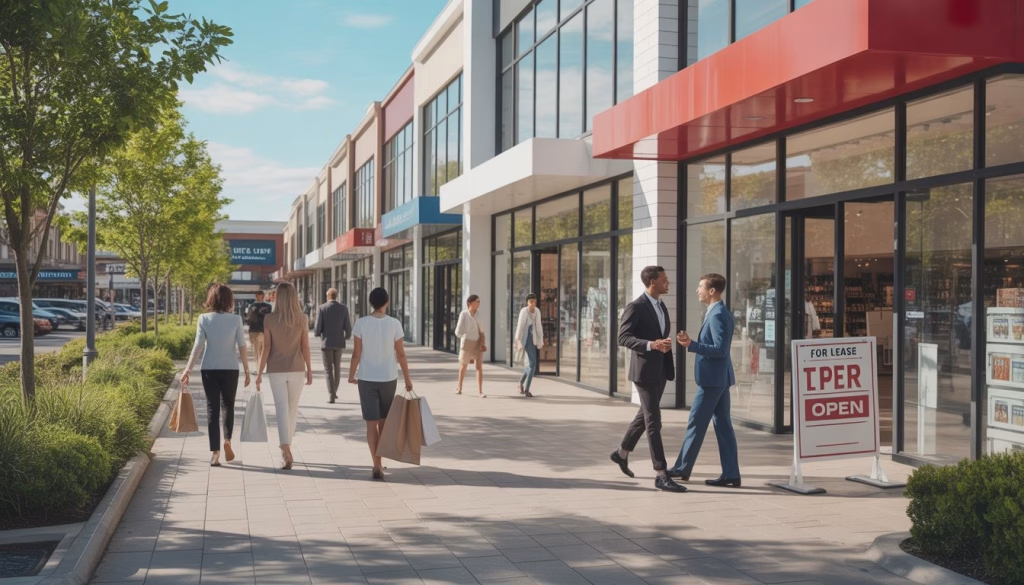Is The Retail Real Estate Recovery Here to Stay?

The retail commercial real estate sector shows a selective recovery in 2025, with transaction volumes down 14.2% year-over-year despite strong pricing momentum. Retail property prices have surged 18.5% annually, reaching $141 per square foot, indicating that while fewer properties are trading, investor confidence in quality retail assets is returning. This divergence between volume and pricing highlights that capital now targets location, tenant quality, and property type.
Your retail investment strategy should address dramatic subsector variations. Automotive retail properties saw median prices jump 36.6% year-over-year, while bars and restaurants posted a 42.2% annual increase, contrasting with other retail categories that continue to struggle as consumer behavior and experiential retail trends reshape investment priorities.
Investors focus on necessity-driven and experiential formats that can withstand economic uncertainty, while traditional retail faces continued pressure from e-commerce and shifting consumer preferences.
Key Takeaways
- Retail property prices increased 18.5% annually despite transaction volumes falling 14.2% year-over-year
- Automotive and restaurant retail assets led price gains with increases exceeding 36% annually
- Recovery remains highly selective with investors focusing on experiential and necessity-based retail formats
Current Drivers of Retail Commercial Real Estate Recovery
Interest rate stabilization and improved market sentiment create favorable conditions for retail property investments. Vacancy rates decline in key markets while rental growth accelerates across multiple retail segments.
Shifting Interest Rates and Market Conditions
Lower borrowing costs improve your investment returns in retail commercial real estate. The commercial real estate market shows signs of recovery as bid intensity increases following earlier economic uncertainty.
You can now access capital at more favorable terms than the previous 18 months. Debt service coverage ratios have improved for retail properties as financing becomes more accessible.
Market conditions favor opportunistic investors seeking distressed retail assets. Properties that struggled during high-rate periods now present acquisition opportunities at reduced valuations.
Key financing improvements include:
- Reduced commercial mortgage rates
- Increased lender appetite for retail projects
- Extended loan terms for qualified borrowers
- Lower debt service requirements
Impact on Vacancy Rates and Rental Growth
Your retail properties benefit from tightening vacancy rates across multiple markets. Strong consumer spending supports tenant demand for prime retail locations.
Vacancy rate trends by property type:
| Property Type | Current Vacancy | 6-Month Change |
|---|---|---|
| Strip Centers | 8.2% | -1.1% |
| Shopping Centers | 6.8% | -0.9% |
| Power Centers | 5.4% | -0.7% |
Rental growth accelerates as available space decreases. You can expect 3-5% annual rent increases in stabilized retail markets through 2025.
Rising homeownership costs drive increased retail foot traffic as U.S. commercial real estate outlook indicates more people frequent neighborhood shopping centers, supporting your rental income stability.
Role of Diversification and Sector Performance
Your portfolio benefits from mixed-use developments that combine retail, residential, and office components. These properties generate multiple income streams and reduce vacancy risk.
Essential retail categories maintain strong occupancy rates:
- Grocery-anchored centers
- Medical and healthcare services
- Quick-service restaurants
- Personal services
Geographic diversification protects your income against regional economic downturns. Markets with diverse employment bases show more stable retail performance than single-industry locations.
Warehouse and logistics properties complement traditional retail holdings. You gain exposure to e-commerce fulfillment demand while maintaining brick-and-mortar retail investments.
Challenges, Opportunities, and Sector Insights in Retail Real Estate

While retail real estate faces ongoing transformation, office properties struggle with hybrid work models, industrial and self-storage sectors demonstrate stronger performance metrics, and property owners increasingly focus on diversified income streams to maintain profitability.
Office Properties: Navigating Hybrid Work and Recovery
Your office properties face significant headwinds as hybrid work patterns reshape tenant demand. Vacancy rates in many markets remain elevated compared to pre-2020 levels, creating downward pressure on rents.
Key challenges you’ll encounter:
- Reduced space requirements from existing tenants
- Flight to quality as companies prioritize premium locations
- Higher capital expenditure needs for modern amenities
Commercial property values have declined more than 20% since 2022, with office properties experiencing the steepest drops. Your refinancing options may improve as borrowing costs decline.
Office-to-apartment conversions present opportunities in select markets. You’ll need to evaluate structural feasibility and local zoning requirements before pursuing these projects.
Recovery indicators to monitor:
- Lease renewal rates above 70%
- Average deal sizes stabilizing
- Construction pipeline adjustments
Industrial Sector and Self-Storage: Comparative Resilience
Your industrial properties continue outperforming other commercial sectors despite some softening. E-commerce demand supports warehouse and distribution facilities, though growth rates have moderated from pandemic peaks.
Self-storage maintains steady fundamentals with consistent occupancy rates. You’ll benefit from recession-resistant characteristics as consumers downsize living spaces and businesses reduce office footprints.
Performance comparison:
| Sector | Occupancy Rate | Rent Growth | Investment Appeal |
|---|---|---|---|
| Industrial | 90-95% | Moderate | High |
| Self-Storage | 85-92% | Stable | Medium-High |
| Office | 75-85% | Declining | Low |
Data centers offer the strongest growth opportunity within industrial real estate. Your investments in this subsector benefit from AI demand and cloud infrastructure expansion.
Supply chain diversification increases demand for smaller distribution facilities closer to population centers.
Evolving Income Strategies for Sustainable Growth
Your income optimization requires diversification beyond traditional lease structures. Percentage rent arrangements help capture tenant success while providing downside protection during market volatility.
Mixed-use developments allow you to balance different revenue streams. Combining retail, residential, and office components reduces single-sector risk exposure.
Revenue enhancement tactics:
- Common area maintenance fee optimization
- Ancillary services like parking and storage
- Property management fee structures
You should evaluate triple-net lease conversions where tenants assume operating expenses. This strategy transfers cost inflation risk while maintaining steady cash flow.
Short-term flexible leasing options command premium rates in select markets. Your ability to adapt lease terms quickly becomes increasingly valuable as tenant needs evolve rapidly.
Technology integration through smart building systems reduces your operating costs while attracting quality tenants willing to pay higher rents for enhanced efficiency and connectivity.
Frequently Asked Questions
How has the commercial real estate market changed over the past five years?
The sector has shifted dramatically since 2020, with the pandemic disrupting property usage and investor priorities. Industrial and multifamily assets gained favor, while office and traditional retail faced challenges from remote work and e-commerce.
What factors are influencing the recovery trajectory of commercial real estate markets?
Monetary policy drives investment decisions as Federal Reserve policies and interest rate changes directly affect financing costs and property values.
Demographic shifts reshape demand; population migration to Sun Belt markets creates opportunities in secondary cities and pressures traditional gateway markets.
Technology adoption changes workspace requirements, with hybrid models reducing office space needs and increasing demand for flexible, technology-enabled properties.
Economic policy uncertainty impacts investor confidence because trade policies and fiscal measures create volatility in capital flows and investment timing.
Supply chain considerations influence location preferences, as proximity to ports, transportation hubs, and distribution networks affects industrial property values.
What are experts projecting for the future of commercial real estate through to 2030?
Market analysis indicates selective recovery patterns will persist, with multifamily and medical office properties likely to outperform.
Office properties face structural headwinds from permanent workplace changes, with continued preference for newer, amenity-rich buildings.
Industrial demand should remain strong as e-commerce growth and supply chain reshoring support long-term fundamentals.
Retail will continue evolving toward experiential and service-oriented formats, while necessity-based properties stabilize.
Interest rate normalization should gradually increase transaction volumes by narrowing bid-ask spreads and improving deal activity.
Would you like to publish a free blog post on this site?
Are you a real estate professional, property manager, or industry expert with valuable insights to share? We welcome guest contributors who can provide unique perspectives and actionable advice for our community of property investors and managers.
Guest posting is an excellent way to share your expertise while building backlinks and connecting with our engaged audience of real estate investors and professionals. Best of all, there’s no charge to publish your post on our site!

Dive deep into the world of real estate investment with this comprehensive case study that brings theory to life.
Investment Real Estate Analysis: A Case Study offers an unparalleled look at the decision-making process behind successful property investments. Follow along as we dissect a real-world scenario, revealing the critical factors that seasoned investors consider before making a move.
From crunching numbers to assessing market conditions, this book walks you through every step of the analysis process. Learn how to evaluate potential investments like a pro, understanding key metrics such as cap rates, cash-on-cash returns, and internal rate of return.
Whether you’re a novice investor or looking to refine your skills, this case study will equip you with the tools to make informed investment decisions in the competitive real estate market.
Get your copy now from your favorite bookseller:
- Amazon
- Books2Read for Apple, Barnes & Noble, Kobo, Scribed, and 8 more sellers with both eBook and paperback options available
- Payhip as a downloadable PDF
Ready to take your business to the next level?
- Subscribe to our newsletter
- Visit the learning center
- Learn more about our consulting services